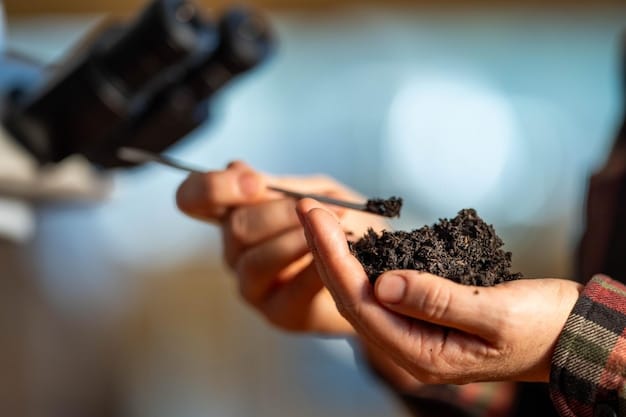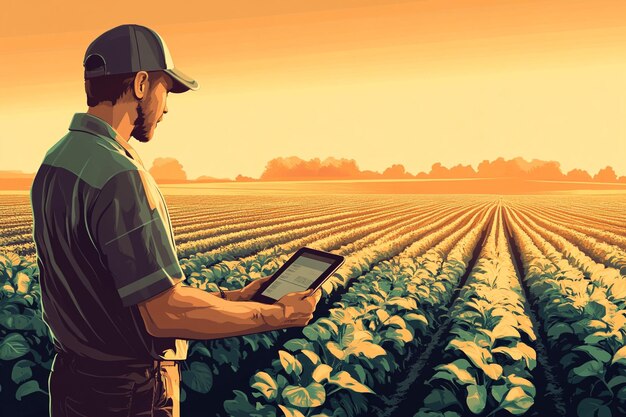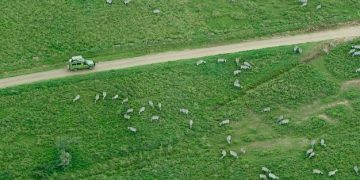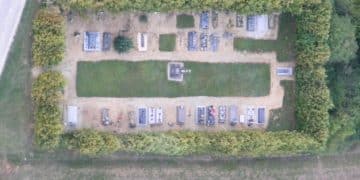Sustainable Agriculture: US Farmers’ Guide to Reduce Chemical Reliance

Exploring the science of sustainable agriculture reveals strategies for US farmers to diminish their dependence on chemical fertilizers and pesticides, enhancing environmental health and long-term productivity through methods like crop rotation, cover cropping, and integrated pest management.
Exploring the science of sustainable agriculture: How Can US Farmers Reduce Their Reliance on Chemical Fertilizers and Pesticides? is a critical question in today’s agricultural landscape. As concerns about environmental impact and human health grow, adopting sustainable practices becomes essential for US farmers seeking long-term viability and resilience.
Understanding the Need for Sustainable Agriculture
Sustainable agriculture focuses on farming practices that are environmentally sound, economically viable, and socially responsible. It aims to minimize negative impacts on ecosystems while ensuring food security for future generations.
The conventional agricultural system, heavily reliant on chemical inputs, faces increasing scrutiny. These chemicals can degrade soil health, pollute water sources, and harm beneficial insects and wildlife.

Environmental Concerns of Chemical Fertilizers and Pesticides
Conventional farming methods often lead to significant environmental problems:
- Soil Degradation: Chemical fertilizers can disrupt soil structure and microbial communities, leading to erosion and reduced fertility.
- Water Pollution: Pesticide and fertilizer runoff contaminate rivers, lakes, and groundwater, harming aquatic life and posing risks to human health.
- Biodiversity Loss: Chemical pesticides indiscriminately harm beneficial insects, birds, and other wildlife, disrupting ecosystems.
By adopting sustainable agriculture, farmers can mitigate these environmental challenges and create a more resilient and balanced farming system.
In conclusion, understanding the critical need for sustainable agriculture highlights the importance of adopting farming techniques that minimize environmental harm while ensuring long-term productivity and ecological balance.
Exploring Crop Rotation for Soil Health
Crop rotation involves alternating different crops in a planned sequence on the same field. This practice breaks pest and disease cycles, improves soil fertility, and reduces the need for chemical inputs.
By diversifying crop types, farmers can create a healthier soil ecosystem that supports plant growth naturally.
Benefits of Crop Rotation
- Reduces Pest and Disease Pressure: Alternating crops disrupts pest and disease life cycles, minimizing infestations and outbreaks.
- Improves Soil Fertility: Different crops have different nutrient requirements, helping to balance soil nutrient levels and improve overall fertility.
- Enhances Soil Structure: Crop rotation can improve soil structure by increasing organic matter content and promoting beneficial microbial activity.
Examples of successful crop rotation systems include alternating legumes (which fix nitrogen) with cereals (which use nitrogen), creating a natural fertilizer effect.

Crop rotation, therefore, is a cornerstone of sustainable agriculture, offering a natural and effective method to improve soil health and reduce reliance on chemical inputs.
Cover Cropping: A Natural Soil Amendment
Cover cropping involves planting specific crops primarily to benefit the soil, rather than for harvest. These crops protect the soil from erosion, suppress weeds, and improve soil structure and fertility.
Common cover crops include legumes, grasses, and brassicas, each offering unique benefits to the soil.
How Cover Crops Benefit the Soil
- Erosion Control: Cover crops protect the soil surface from wind and water erosion, preventing soil loss during heavy rains or strong winds.
- Weed Suppression: Cover crops compete with weeds for resources, reducing weed pressure and the need for herbicides.
- Nutrient Cycling: Cover crops can scavenge nutrients from the soil, preventing nutrient leaching and making them available to subsequent cash crops.
Effective cover cropping strategies involve selecting the right cover crop species for specific soil types and nutrient needs, and terminating the cover crop at the appropriate time to maximize its benefits.
In summary, cover cropping is a valuable technique for naturally improving soil health and minimizing the need for chemical fertilizers, contributing to a more sustainable farming system.
Integrated Pest Management (IPM) Strategies
Integrated Pest Management (IPM) is a holistic approach to pest control that emphasizes prevention and uses pesticides only as a last resort. It combines various strategies to manage pests effectively while minimizing environmental impact.
IPM aims to maintain pest populations below economically damaging levels through a combination of biological, cultural, and chemical controls.
Components of Integrated Pest Management
- Monitoring and Scouting: Regularly monitoring fields to identify pests and assess their population levels.
- Biological Control: Using natural enemies such as predators, parasites, and pathogens to control pests.
- Cultural Practices: Implementing farming practices that make the environment less favorable for pests, such as crop rotation and sanitation.
Examples of IPM include using beneficial insects like ladybugs to control aphids and employing crop rotation to disrupt pest life cycles.
Integrated Pest Management provides a sustainable and effective approach to pest control, reducing reliance on chemical pesticides and promoting a healthier ecosystem.
Composting and Manure Management
Composting and manure management are essential practices for enriching soil with organic matter and reducing the need for synthetic fertilizers. Compost and manure provide essential nutrients for plant growth and improve soil structure and water-holding capacity.
Properly managed compost and manure can also reduce the risk of nutrient runoff and water pollution.
Benefits of Composting and Manure
Composting and manure offer a multitude of advantages:
- Nutrient Enrichment: Compost and manure deliver vital nutrients to plants, fostering vigorous expansion and abundant yields.
- Improved Soil Structure: The integration of organic matter enhances soil structure by fostering aggregation, thereby ameliorating water infiltration and aeration.
- Water Conservation: Organic matter boosts the soil’s capacity to retain water, decreasing the necessity for recurrent irrigation.
Ensuring effective management entails meticulously monitoring composting conditions and applying manure at advisable rates to avert nutrient surplus and sanitation concerns.
In overview, composting and manure administration constitute indispensable components of sustainable agronomy, furnishing an environmentally sustainable methodology to enrich soil health and curtail dependency on manufactured fertilizers.
Precision Agriculture and Technology
Precision agriculture involves using technology to optimize farming practices and reduce waste. It utilizes data and technology to tailor inputs to specific areas of the field, maximizing efficiency and minimizing environmental impact.
Technological tools such as GPS, sensors, and drones enable farmers to make informed decisions about irrigation, fertilization, and pest control.
How Precision Agriculture Enhances Sustainability
Precision Agriculture offers a range of enhancements:
- Optimized Input Use: Precision tech adjusts irrigation and fertilizer based on specific field requirements, curtailing waste and ecological ramifications.
- Enhanced Monitoring: Sensors and drones present continuous crop monitoring, enabling swift problem intervention and averting crop detriment.
- Data-Driven Decision-Making: Precision technologies provide farmers the means to take data-oriented judgments, refining agronomic methods for utmost yield and sustainability.
Example tactics encompass employing GPS-led machinery for accurate fertilizer allotment and leveraging drone imagery to spot pest hotspots for designated treatment.
In conclusion, precision agronomy furnishes farmers with the wherewithal to fine-tune agronomic methods, lessen ecological repercussions, and bolster the sustainability of their enterprises.
Government Programs and Incentives
Government programs and incentives play a crucial role in supporting sustainable agriculture. These initiatives provide financial assistance, technical support, and educational resources for farmers adopting sustainable practices.
Federal and state programs aim to promote environmental stewardship, improve soil health, and reduce reliance on chemical inputs.
Examples of Government Support
Government Support can include the following programs:
- Environmental Quality Incentives Program (EQIP): EQIP provides financial and technical assistance to farmers adopting conservation practices.
- Conservation Stewardship Program (CSP): CSP rewards farmers for actively managing and improving their land through conservation activities.
- Sustainable Agriculture Research and Education (SARE): SARE funds research and education projects focused on sustainable agriculture practices.
By leveraging these government programs, farmers can access the resources and support needed to transition to more sustainable farming systems.
Therefore, government incentives are vital in advancing sustainable agronomy, furnishing farmers with the wherewithal and inspiration to embrace eco-conscious agronomic methods, fostering environmental stewardship and agronomic endurance.
Key Point
Brief Description
🌱 Soil Health
Enhances soil structure and fertility through practices like crop rotation and cover cropping.
🐛 Pest Management
Uses natural predators and cultural practices to minimize pesticide use.
💧 Water Conservation
Improves water retention and reduces runoff through composting and conservation tillage.
💰 Economic Viability
Increases long-term farm profitability by reducing input costs and environmental risks.
Frequently Asked Questions
Exploring the science of sustainable agriculture: How Can US Farmers Reduce Their Reliance on Chemical Fertilizers and Pesticides?
Can crop rotation really make a difference in fertilizer use?
Yes, crop rotation can significantly reduce the need for chemical fertilizers by naturally improving soil fertility through the alternating planting of nitrogen-fixing crops.
How does integrated pest management help farmers cut back on pesticides?
IPM utilizes a combination of methods, like biological controls and monitoring, to manage pests, reducing the need for broad-spectrum pesticides that can harm beneficial insects.
What are the primary benefits of using compost and manure on my farm?
Compost and manure enrich the soil with organic matter, improving its structure, water retention, and nutrient content, which supports healthier plant growth without synthetic fertilizers.
Is precision agriculture really worth the investment for sustainable farming?
Precision agriculture optimizes the use of resources like water and fertilizers, delivering them exactly where needed, which significantly reduces waste and environmental impact.
Are there specific government programs I can use to adopt sustainable practices?
Yes, programs like EQIP and CSP offer financial and technical assistance for implementing sustainable farming techniques, making it more accessible for farmers.
Conclusion
Sustainable agriculture presents a pathway for US farmers to reduce their reliance on chemical fertilizers and pesticides, promoting environmental health, economic stability, and long-term food security through practices like crop rotation, IPM, and precision agriculture. By embracing these methods, farmers can create resilient and thriving agricultural systems.
Read more content





